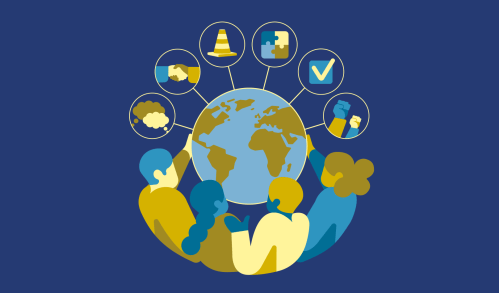In our first piece, we introduced the Knowing-Doing Network Leadership Coalition as a global network comprised of eleven organizations that are uniting to explore and understand how education systems can transform to prioritize a breadth of skills for all children. We wrote: “The promise governments and non-state providers make to parents when they enroll their children in schooling systems is that they will receive knowledge, skills, competencies, and values to enable them to succeed in life.” This commentary focuses on three main result areas: barriers to school entry, struggles that children and youth face at school, and broader outcomes that are evident within and beyond formal schooling.
Barriers to entry: Access to schooling
Education systems are not delivering on their promises and obligations to children and families. For most children, the educational journey begins with formal schooling. Yet, despite concerted global efforts such as the Millennium Development Goals and Sustainable Development Goals (SDGs), recent data suggests that at least 250 million children and young people worldwide still lack access to education. A significant portion of this statistic represents children who have never been to school, while others have dropped out, with many adolescents becoming disengaged from the schooling process and retreating from civic agency. The crisis is particularly acute in certain locations where completion rates for primary education remain alarmingly low, highlighting a substantial disparity between promised and actual educational outcomes. Pakistan and Nigeria, for example, grapple with significant challenges in providing educational access, and together account for almost one-sixth of the global out-of-school population. Markers of equity, such as living in a rural location, being a girl and living in socieoeconomic disadvantage drive and exacerbate this challenge.
Foundational learning outcomes
For children and young people who are able to access school, the gains are often small. The call for for education systems to take a holistic approach to measuring educational outcomes is gaining momentum, with governments being encouraged to focus not only on academic skills but also on others, including socioemotional and creative thinking skills. One measure of learning that has grown in prominence over the last decade, however, is foundational literacy and numeracy (FLN). Learning poverty data from the World Bank suggests that more than half of primary and lower secondary school-aged children do not meet minimum benchmarks in literacy and numeracy. While this measure does not fully capture the breadth of skills that children should build while in school, it is nevertheless a telling one. The deficiency in FLN skills is a pervasive issue, with over half of primary and lower secondary school-aged children lacking fundamental reading and math abilities. While this challenge is a global one, it is most acute in sub-Saharan Africa, where almost 9 out of 10 children are unable to read a simple sentence by their 10th birthday. Although 191 member countries of the United Nations have pledged to try and achieve SDG 4, which includes indicators for FLN, it is apparent that reaching the targets remains a significant challenge for education systems around the world.
Socioemotional learning
The effects of the COVID-19 pandemic on children, particularly on adolescents, cannot be overstated. These effects (trauma, anxiety, depression) linger. For all children and youth, the pandemic meant lockdowns, disengagement from peers, lack of access to critical support of teachers and other trusted adults, death of loved ones, and loss of food and safety that schools and schooling can provide. The pandemic affected everyone around the world, including the teachers and staff that were on the front line of receiving young people back to learning spaces. Schools are an opportunity to be spaces for healing and socioemotional growth and development now more than ever.
Despite its critical importance for individual well-being and success, socioemotional learning is still often overlooked in current education systems. Recent data suggest a concerning decline in social and emotional competencies among students, with disadvantaged students and girls disproportionately affected by these trends. In one study, 15-year-olds were found to demonstrate lower social and emotional skills than 10-year-olds, with the decline most apparent in creativity and curiosity. Students that are struggling to be present and engage in emotional growth and learning will struggle to learn academic skills, and they will struggle to thrive. Global education systems represent a rich opportunity for the development of socioemotional skills.
Impacts beyond the classroom
There are other indicators that education systems are not fully preparing young people to thrive. The escalating mental health crisis, marked by soaring suicide rates among adolescents, underscores the urgent need for comprehensive mental health interventions within educational settings. Furthermore, children are not being taught the skill sets needed to navigate local and global challenges like intolerance, the spread of disinformation, and climate change. Access to school can serve as a pivotal platform for addressing these challenges and promoting overall well-being.
While these data are better understood in context, the universal picture is not encouraging, particularly from an equity lens, because when we layer onto these realities the rapid rate of acceleration in artificial intelligence it is apparent that the underserved and marginalized continue to draw the short straw. The risks of exacerbating inequity are great, and it is urgent for education systems at all levels to recognize the trajectory of their young citizens is fundamental.
Schools and school systems can play a pivotal role in reversing the trends highlighted in this commentary. When children and families are given access to and attend school, education systems can leverage the time spent in classrooms to develop skills in literacy and numeracy, socioemotional learning, civic agency, and climate sensitivity.
Conclusion
Systems can and must do a better job of designing spaces, curricula, and teacher education programs that promote overall well-being, particularly for those students who may lack support elsewhere. The KDNLC is deeply committed to ensuring that children and young people can develop a breadth of skills that are required for thriving. It is however unlikely that nations can achieve this impact without a commitment to systemic transformation.
In our next piece, we will describe how the KDNLC is prioritizing education systems transformation via the approach of an impact network. We will highlight why we believe that building a movement of mission-aligned education actors with deep understanding of their unique contexts is one of the most effective and sustainable ways to foster systemic transformation towards a breadth of skills for all learners.





Commentary
Are education systems delivering on their promise?
June 14, 2024